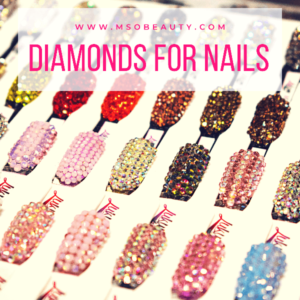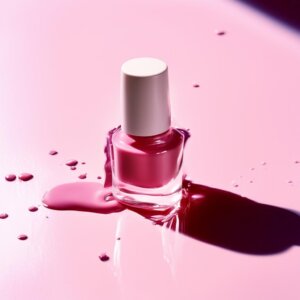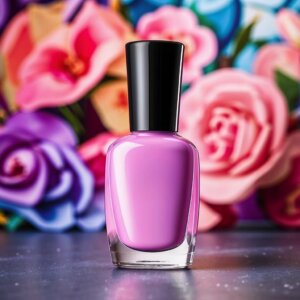There are so many nail extension building techniques available today that it’s easy to get confused. If you want to try acrylic nails you may wonder, do you need a UV lamp for acrylic nails?
But don’t fret! This article will get you covered. I’ll explain everything there is to know about UV lights and acrylic nails.

Do you need a UV lamp for acrylic nails?
In short — no:
You don’t need a UV lamp for building acrylic nail extensions or acrylic nail overlays.
Acrylic nails simply air dry in about 10-15 minutes.
How do I cure acrylic nails without a UV light?
Acrylic nails are made using the polymerization reaction of the acrylic material.
The acrylic material is made from acrylic powder bound together with monomer.
This makes acrylic systems different from builder gels and polygels for building nail extensions.
Gel and polygel systems don’t consist of two components. They come ready to apply right out of the tube or jar.
However, gels and polygels harden only under a UV or an LED lamp.
Here’s how acrylic nails dry without a UV lamp
You need to dip your brush in monomer, wipe the excess liquid against the dappen dish and pick a bit of acrylic powder with the wet brush.
This creates an acrylic bead, which is the building block of acrylic nails.
So when you mix the acrylic powder with monomer they turn into a pliable material that you can use to shape your artificial nails.
The polymerization reaction of the powder and monomer begins right after you create your acrylic bead.
This makes acrylic nails different from gel and polygel nails, where the polymerization only happens under a UV lamp.
So when you pick up the acrylic bead the acrylic material starts to air dry and sets slowly.
You still have some time to shape your nails. But you need to work quickly.
Acrylic nails fully dry and become hard in about 10-15 minutes after you have mixed the monomer with the powder.
So you don’t need a UV light for drying acrylic nails. The drying process happens on its own, without any tools or gadgets.
How do I check whether my acrylic nails have dried without a UV lamp?
Once your acrylic nails look to have dried, you can perform a simple test to check whether they have fully hardened.
Just tap the end of your acrylic brush against the nails you want to check.
If you hear a clicking sound the nails are fully cured. Now you can file and buff them to perfection.
But If your brush sticks to the nail’s surface you’ll need to wait for the polymerization process to finish. If you’ve damaged the nail’s surface by tapping while it’s still soft, you can simply smooth out the acrylic nail with the brush or add a bit more material.
Can acrylic material fail to polymerize if I don’t use a UV lamp for acrylic nails?
Your acrylic nails can fail to polymerize only if you get the consistency of your acrylic bead wrong.
If your acrylic bead comes out too wet or too dry the acrylic material may fail to polymerize or stick to your nails.
A UV lamp can’t change the consistency of the acrylic material so it doesn’t have any effect on the outcome of the acrylic nail polymerization process.
Can a UV light speed up the polymerization of acrylic nails?
No, you don’t need a UV lamp for increasing the drying speed of acrylic nails at all.
Again, it won’t do anything and won’t speed up the curing process of acrylic nails.
As you can see, a UV light is useless for building acrylic nails.
That’s why almost no acrylic nail kits contain UV or LED lamps.
How can I speed up the curing process of acrylic nails without a UV lamp?
The speed of the acrylic material polymerization reaction depends on the surrounding temperature and the temperature of the acrylic powder and monomer.
The warmer the temperature the faster it cures and the colder it is the slower the polymerization process goes.
What does the surrounding temperature mean?
It’s the temperature in the room where you are doing your acrylic nails.
The temperature of your or your client’s hands.
How to speed up the acrylic polymerization process?
If you want to speed up the curing process without a UV light then you can store your monomer and powders in a warm place, heat them by holding their jars under warm water, doing your nails in a warm room, turning the heat up in the room where you’re doing nails, warming up your or your client’s hands.
How to slow the acrylic polymerization process down?
You may want to slow the curing process down if you are a newbie who needs to work slowly or if you’re working on a complex sculpted design.
In that case, you can store your acrylic materials in a cold place, do your manicure in a cool and well-ventilated room, hold your or your client’s hands under cold water before doing your acrylic manicure.
But after your acrylic nails have dried, they can withstand any temperature changes without cracking. The acrylic material is very durable and strong.
You may still need a UV lamp for acrylic nails — if you use a gel polish or top coat
The only time when you need to use a UV lamp for acrylic nails is when you coat these nails with a gel top coat or gel nail polish.
Many nail technicians love to finish their acrylic manicure off with a layer of gel top coat.
This may be necessary to give the acrylic nails a high-gloss shine. That’s where a glossy top coat comes in handy.
Or you may want to create a matte finish on your acrylic nails. Use matte gel top coat for this look.
Of course, gel top coats require a UV light to get cured.
You may want to use gel nail polish on acrylic nails if you want to paint your nails with a color that you don’t have in your acrylic nail kit.
You may also need to use gel polish and gel top coat over your acrylic nails if you’d like to create a nail design, draw nail art, place diamonds, foil, or other decorations on your nail extensions.
So you’ll have to use a UV or an LED light to cure every layer of that polish on your acrylic nails.
In addition to that, you’ll need to use a UV lamp for curing the layer of gel top coat that you’re going to seal your nail designs with.
By the way, there’s no need to use a gel base coat with acrylic nails
You don’t need to use a gel base coat over your natural nail plate under your acrylic nails either.
This is because acrylic material binds to the natural nails very well without any base coat underneath.
You don’t need to use any base coat under gel nail polish when you apply it over your acrylic nails.
Gel nail polish adheres to acrylic nails perfectly, even better than to natural nails.
Final thoughts
To wrap things up, you don’t need a UV lamp for building and polymerizing acrylic nails.
A UV lamp won’t speed up the acrylic drying process.
Your nails will air dry on their own in 10-15 minutes.
The polymerization speed depends on the temperature of the acrylic powder and monomer, and the surrounding temperature.
But you may need a UV lamp for curing gel top coat or gel nail polish that you can paint your nails with to enhance their appearance.
I hope that this article has answered all your questions. You can find more information about acrylic nails and gel nail polishes in my website.
Recommended reading:
Best Professional Gel Nail Polish Brands Used In Salons
Non-Toxic Gel Nail Polish Brands 101: Choose The Safest Gel Nail Polish
Overlay Nails 101: Acrylic And Gel Nail Overlay On Natural Nails – The Ultimate Guide
Why Are My Gel Nails Lifting? 15 Reasons Why Your Gel Polish Is Lifting
Best No Light Gel Polish — Gel Nail Polish Without UV Light
Most Popular Shellac Colors – The Ultimate List Of 15 Best Shellac Colors For Fantastic Manicures
13 Best Korean Night Cream Products That Are Popular For A Reason
Best Gel Base And Top Coat: The Updated List Of The Best Gel Nail Base And Top Coat Sets
Best Small Salon Reception Desk For A Tight Space: Make An Amazing First Impression!
Nail File Grit Guide And Chart
13 Best Korean Snail Serum Products That May Seem Too Good To Be True
Best Nail Dehydrator And Primer: The Ultimate Guide
12 Best Polygel Nail Kit Reviews And How To Apply Polygel At Home
10 Best UV and LED Nail Lamp Units For Gorgeous Gel Nails
7 Best Korean Peel-Off Mask Products For Improving Skin Texture
How To Shape Almond Nails — The No Nonsense Guide
11 Best Nail Files For Natural Nails That’ll Make Nail Shaping Easier
Nail Shapes Chart And Types Of Nail Shapes 2021 — The Ultimate Guide
10 Best Korean Cleansing Balm Products That’ll Probably Be Your New Skincare Secret
15 Best Korean Foam Cleanser Products For All Skin Types
7 Best Magnets For Nail Polish To Help You Create Stunning Cat-Eye Nails
10 Best Nail Polish Pens And Pen Sets To Make Easy Nail Art At Home
14 Best Nude Gel Nail Polish Colors For Every Skin Tone
How To Remove Gel Nail Polish From Acrylic Nails Without Ruining Them: 2 Proven Ways
How To Thicken Nail Polish For Stamping Easily?
Do I Need A Base Coat For Gel Nails? Here’s The Answer!
Do You Need A UV Lamp For Acrylic Nails?






